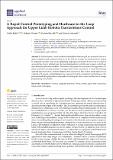| dc.contributor.author | Bodo, Giulia | |
| dc.contributor.author | Tessari, Federico | |
| dc.contributor.author | Buccelli, Stefano | |
| dc.contributor.author | Laffranchi, Matteo | |
| dc.date.accessioned | 2024-03-12T19:24:31Z | |
| dc.date.available | 2024-03-12T19:24:31Z | |
| dc.date.issued | 2024-02-29 | |
| dc.identifier.issn | 2076-3417 | |
| dc.identifier.uri | https://hdl.handle.net/1721.1/153662 | |
| dc.description.abstract | In the last decade, robotic-mediated rehabilitation has emerged as a potential solution to improve repetitive task training. Each device in this field has a unique development history shaped by engineers’ expertise in specific programming languages or platforms. In this work we adopt an approach that tries to abstract from the final implementation with the aim to make control logic more shareable and understandable. The authors will present the outcomes of the application of a Rapid Control Prototyping strategy to an upper-limb robotic exoskeleton. A model-based design approach implemented on a real-time target machine is presented. This modern design approach was explored with several control strategies and was used to test the exoskeleton’s performances. The proposed method highlights how it is possible to develop the entire control architecture in a single programming environment. | en_US |
| dc.publisher | Multidisciplinary Digital Publishing Institute | en_US |
| dc.relation.isversionof | 10.3390/app14052017 | en_US |
| dc.rights | Creative Commons Attribution | en_US |
| dc.rights.uri | https://creativecommons.org/licenses/by/4.0/ | en_US |
| dc.source | Multidisciplinary Digital Publishing Institute | en_US |
| dc.subject | Fluid Flow and Transfer Processes | en_US |
| dc.subject | Computer Science Applications | en_US |
| dc.subject | Process Chemistry and Technology | en_US |
| dc.subject | General Engineering | en_US |
| dc.subject | Instrumentation | en_US |
| dc.subject | General Materials Science | en_US |
| dc.title | A Rapid Control Prototyping and Hardware-in-the Loop Approach for Upper Limb Robotic Exoskeletons Control | en_US |
| dc.type | Article | en_US |
| dc.identifier.citation | Applied Sciences 14 (5): 2017 (2024) | en_US |
| dc.contributor.department | Massachusetts Institute of Technology. Computer Science and Artificial Intelligence Laboratory | |
| dc.relation.journal | Applied Sciences | en_US |
| dc.identifier.mitlicense | PUBLISHER_CC | |
| dc.eprint.version | Final published version | en_US |
| dc.type.uri | http://purl.org/eprint/type/JournalArticle | en_US |
| eprint.status | http://purl.org/eprint/status/PeerReviewed | en_US |
| dc.date.updated | 2024-03-12T16:38:23Z | |
| dspace.date.submission | 2024-03-12T16:38:23Z | |
| mit.journal.volume | 14 | en_US |
| mit.journal.issue | 5 | en_US |
| mit.license | PUBLISHER_CC | |
| mit.metadata.status | Authority Work and Publication Information Needed | en_US |
